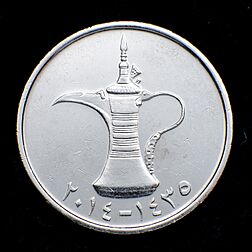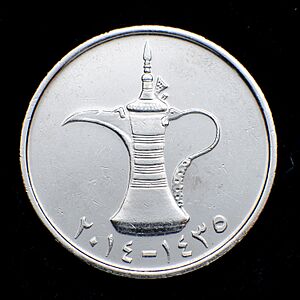United Arab Emirates dirham facts for kids
Quick facts for kids United Arab Emirates dirham |
|||
|---|---|---|---|
|
|||
| ISO 4217 Code | AED | ||
| User(s) | United Arab Emirates | ||
| Inflation | 1.87% | ||
| Source | The World Factbook, 2023 | ||
| Pegged with | USD US$1 = Dhs 3.6725 |
||
| Subunit | |||
| 1⁄100 | fils (فلس) | ||
| Symbol | د.إ | ||
| Coins | |||
| Freq. used | 25, 50 fils, Dh1 | ||
| Rarely used | 1, 5, 10 fils | ||
| Banknotes | Dhs5, Dhs10, Dhs20, Dhs50, Dhs100, Dhs200, Dhs500, Dhs1,000 | ||
The Emirati Dirham (say "deer-ham") is the official money of the United Arab Emirates (UAE). Its symbol in Arabic is د.إ, and in English, people often use Dh (for one) or Dhs (for more than one). The special code for the Dirham is AED.
One Dirham is made up of 100 smaller units called fils (say "fills"). The Dirham is connected to the United States Dollar. This means that US$1 is always worth about 3.67 Dirhams. This makes the Dirham's value very stable.
Contents
History of the Dirham
The name dirham comes from an old Greek word, drakhmé. This name has been used for money for hundreds of years, even through the time of the Ottoman Empire.
Before 1966, the different states that now make up the UAE used a currency called the Gulf rupee. This money was linked to the Indian rupee. In 1966, the Indian rupee's value changed. Because of this, many of the states decided to use different money.
Most of the states, except Abu Dhabi, started using the Qatar and Dubai riyal. For a short time, they even used the Saudi riyal. But Abu Dhabi chose to use the Bahraini dinar instead.
Then, in 1973, the UAE was formed. All the states decided to use one new currency: the UAE Dirham. This made it much easier for everyone to buy and sell things across the country.
Coins of the UAE
In 1973, the first UAE coins were made. They came in values of 1, 5, 10, 25, and 50 fils, and 1 dirham. The smaller coins (1, 5, and 10 fils) were made from bronze. The larger coins were made from a mix of copper and nickel.
In 1995, some of the coins were made smaller. The 50 fils coin even changed its shape to a special seven-sided one. The numbers and values on the coins are written in Eastern Arabic numerals, and the words are in Arabic.
Today, the 1, 5, and 10 fils coins are not used very often. So, prices are usually rounded to the nearest 25 fils. The 1 fils coin is very rare to see. Sometimes, people might confuse the old 50 fils coin with the modern 1 dirham coin because they are similar in size.
Since 1976, the UAE has also made special commemorative coins. These coins celebrate important events or leaders in the country.
Coin Details
| Image | Value | Technical details | What's on it | ||||||
|---|---|---|---|---|---|---|---|---|---|
| Front | Back | Size | Thickness | Weight | Edge | Shape | Front side | Back side | |
| 1 fils | 15 mm | 1.1 mm | 1.5 g | Smooth | Round | Three date palms. | Words: "UNITED ARAB EMIRATES" and "1 fils". | ||
| 5 fils | 19 mm | 1.65 mm | 2.9 g | Smooth | Round | A fish (Lethrinus nebulous). | Words: "UNITED ARAB EMIRATES" and "5 fils". | ||
| 10 fils | 17 mm | 1.2 mm | 2.2 g | Smooth | Round | A dhow (a traditional boat). | Words: "UNITED ARAB EMIRATES" and "10 fils". | ||
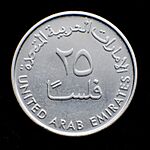 |
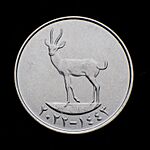 |
25 fils | 20 mm | 1.5 mm | 3.5 g | Ridged | Round | A Gazelle (an animal). | Words: "UNITED ARAB EMIRATES" and "25 fils". |
 |
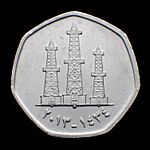 |
50 fils | 21 mm | 1.7 mm | 4.4 g | Smooth | Seven-sided | Three oil derricks (oil drilling towers). | Words: "UNITED ARAB EMIRATES" and "50 fils". |
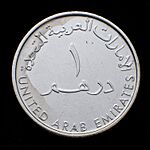 |
 |
Dh 1 | 24 mm | 2 mm | 6.1 g | Ridged | Round | A Dallah (a traditional coffee pot). | Words: "UNITED ARAB EMIRATES" and "1 dirham". |
Coin Problems
Sometimes, coins from other countries are very similar in size to the UAE Dirham. For example, the one peso coin from the Philippines is almost the same size as a one Dirham coin. But one peso is worth much less than one Dirham. This has caused problems with vending machines in the UAE, as people could use the cheaper coins.
Other coins that are similar in size include Pakistan's 5 rupee coin, the Omani 50 Baisa coin, and the Moroccan 1 dirham. To help stop fake money, all Dirham banknotes have a special falcon watermark.
Banknotes of the UAE
On May 20, 1973, the UAE started printing banknotes. The first notes were in values of 1, 5, 10, 50, and 100 dirhams. A 1,000 dirham note was added in 1976.
Over the years, new notes were introduced and some old ones were removed. For example, a 500 dirham note came out in 1983, and a 200 dirham note in 1989. The 1,000 dirham note was brought back in 2000.
Today, you can find banknotes in these values: Dhs5 (brown), Dhs10 (green), Dhs20 (light blue), Dhs50 (purple), Dhs100 (pink), Dhs200 (green/brown), Dhs500 (navy blue), and Dhs1,000 (greenish blue).
The front of the banknotes has text in Arabic with numbers in Eastern Arabic numerals. The back of the notes has text in English with regular numbers.
In recent years, the UAE has started making new banknotes from a special material called polymer. These notes are more durable and have new security features. The first polymer note, a Dhs50 note, was released in 2021 to celebrate the UAE's 50th birthday. New Dhs5 and Dhs10 polymer notes came out in 2022, and Dhs1000 and Dhs500 notes followed in 2023.
Banknote Designs (2003 series)
| Image | Value | Main Color | Size (mm) | What's on it | ||
|---|---|---|---|---|---|---|
| Front | Back | Front side | Back side | |||
| [1] | Dhs 5 | Brown | 143 × 60 | Sharjah Central Souq (a market). | Imam Salem Al Mutawa Mosque. | |
| [2] | Dhs 10 | Green | 147 × 62 | A Khanjar (a traditional dagger). | A pilot farm. | |
| [3] | Dhs 20 | Blue | 149 × 63 | Dubai Creek Golf and Yacht Club. | A traditional trading dhow (boat). | |
| [4] | Dhs 50 | Purple | 151 × 64 | An Oryx (a type of antelope). | Al Jahili Fort, an old fort in Al Ain. | |
| [5] | Dhs 100 | Red | 155 × 66 | Al Fahidi Fort. | Dubai World Trade Centre building. | |
| [6] | Dhs 200 | Dark Yellow | 157 × 67 | The Zayed Sports City Stadium and a Sharia court building. | The Central Bank of the UAE building in Abu Dhabi. | |
| [7] | Dhs 500 | Sky blue | 159 × 68 | A Saker falcon. | The Jumeirah Mosque. | |
| [8] | Dhs 1,000 | Brown | 163 × 70 | Qasr al-Hosn (a historic palace). | View of Abu Dhabi skyline. | |
Banknote Designs (2021-2023 series)
| Image | Value | Main Color | Size (mm) | What's on it | ||
|---|---|---|---|---|---|---|
| Front | Back | Front side | Back side | |||
| [9] | Dhs 5 | Orange | 143 × 60 | Ajman fort. | Dhayah Fort in Ras al Khaimah. | |
| [10] | Dhs 10 | Green | 147 × 62 | Sheikh Zayed Grand Mosque. | Khor Fakkan Amphitheatre. | |
| [11] | Dhs 50 | Purple | 151 x 64 | Sheikh Zayed Al Nahyan and other founding fathers of the UAE. | Sheikh Zayed signing a union document. | |
| [12] | Dhs 500 | Light Blue | 159 × 68 | Terra Sustainability Pavilion in Expo Dubai. | Museum of the Future in Dubai, Emirates Towers, Burj Khalifa. | |
| [13] | Dhs 1,000 | Brown | 163 × 70 | Sheikh Zayed and the "Hope" probe (a space mission). | Barakah nuclear power plant in Ruwais. | |
How the Dirham is Valued
Since November 1997, the Dirham has been officially linked to the U.S. dollar. This means that the exchange rate between the two currencies stays almost the same: US$1 is always equal to about Dhs 3.6725. This helps keep the UAE's economy stable.
| Current AED exchange rates | |
|---|---|
| From Google Finance: | AUD CAD CHF EUR GBP HKD JPY USD SAR BHD INR |
| From Yahoo! Finance: | AUD CAD CHF EUR GBP HKD JPY USD SAR BHD INR |
| From XE.com: | AUD CAD CHF EUR GBP HKD JPY USD SAR BHD INR |
| From OANDA: | AUD CAD CHF EUR GBP HKD JPY USD SAR BHD INR |
| From fxtop.com: | AUD CAD CHF EUR GBP HKD JPY USD SAR BHD INR |
See also
- Economy of the United Arab Emirates
- Moroccan dirham


